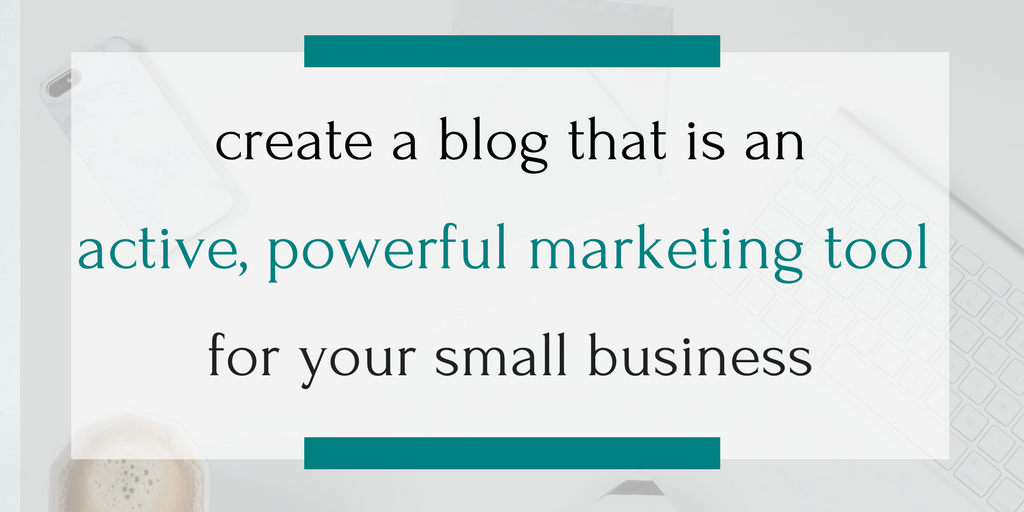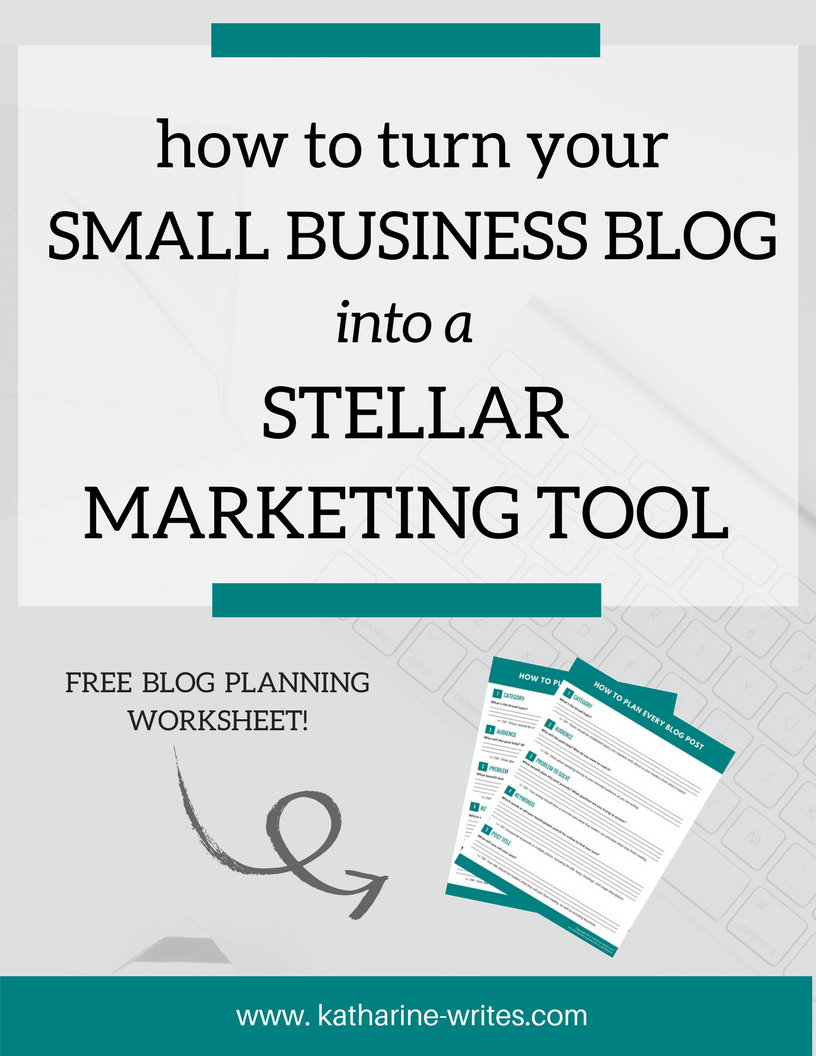Are you writing a blog for your business?
Of course, you’re already publishing only your best content. You take time to write interesting posts. You are using all the tricks you can to make your blog posts more awesome and engaging. You’re doing your best to write a good blog.
But you don’t just want to write a good blog. You’re a business owner, after all. If you’re going to take the time and put in the effort of creating a business blog, you want it to do some heavy lifting. You want it to promote your business.
You want a blog that is an active, useful, powerful marketing tool for your business. But how do you make that happen?

1. Choose Relevant Content
The term “relevant content” usually means that you are writing about a topic relevant to your readers.
Which makes sense — if it doesn’t benefit them, your audience isn’t going to care about your blog post, right?
But there’s another form of relevant content that’s important when turning your business blog into a marketing tool, and that’s content that is relevant to your business.
More importantly, it is content that is relevant to the current marketing goals of your business.
Now, these two things are of course connected. After all, your marketing strategy revolves around the needs and interests of your customers!
But when putting together blog posts, you need to think strategically about both the needs of your customers and what is happening with your business. Ask yourself:
- What events or products am I planning right now?
- What products am I going to launch in the near future?
- What keywords do I want to add to my SEO?
- What seasonal sales or promotions are coming up?
- What sort of work do I want to focus on?
- What do I want customers to know about my business?
- What questions are customers asking that I can answer?
All of these things relate to your marketing, which means they need to be part of your blogging strategy too.
Relevant content is blog content that relates to your overall marketing strategy. When you ask yourself these questions, you create a blog that isn’t just about sharing information — it’s about strategically advancing your business goals.
Because isn’t that what a stellar marketing tool should do?
Psst — do you have trouble planning out how “relevant content” will integrate with search keywords and your marketing plan? This free worksheet will help you plan it all out for every post:
2. Create Powerful Headlines
Whether readers find your blog posts through a search engine, on social media, or by visiting your website directly, the headline is usually the first thing they see.
If that headline isn’t powerful, engaging, and informative, then they are a whole lot less likely to click on it.
Headlines need to hit a sweet spot of not being too vague but not giving too much away. For example, headlines like…
- Buy an Engagement Ring
- Find a Wedding Photographer
- Online Security Tips
…are far too vague. They won’t interest readers because they don’t stand out. They don’t show how this post will help solve a specific problem in a way that no one else can.
But you can also be too specific when writing a headline for your blog post. Being too specific doesn’t engage your readers or draw in their attention. For example, headlines like…
- Many Couples Buy Engagement Rings They Can’t Afford
- Talk to More Than One Wedding Photographer Before Choosing
- Use Online Security Software to Keep Your Customers’ Information Safe
…tell readers everything they need to know about the content you’re sharing, meaning that they don’t actually need to read the rest of the post. Better headlines would be:
- 10 Things You Need to Know Before You Buy an Engagement Ring
- The Question Every Couple Should Ask Their Wedding Photographer
- Are You Putting Your Customers’ Private Information at Risk?
These headlines post a question or offer potential information. They tell readers what they will learn and why it is relevant to them — without giving away what the actual article content will be.
3. Promote the Heck Out of It
There’s not much point in creating awesome content on your business blog if no one sees it, right?
And while you will hopefully have some readers and shoppers and new customers stumble on your blog by way of a Google search — especially if you are using those keywords — you also need to take your content to them.
Because “build it and they will come” doesn’t always work in the land of the internet, where thousands of people are building thousands of blog posts every day.
You should plan to promote every blog post in 3-5 places to get the most traction and attention. Need some ideas for where to share them?
1. On social media. This is what you have those accounts for!
Share the link on your Facebook page. Craft multiple, engaging tweets that all link back to your new post. Pin the image and an intriguing description on Pinterest. Pop a graphic up on your Instagram account and let followers know that the link is in your bio.
Whichever social media accounts you use, make sure you are using them to share your blog content.
2. On LinkedIn. LinkedIn Pulse gives users the opportunity to post their own content, and it finds and promotes the best ones for you.
Share your blog post here, and be sure to include a link at the end letting readers know where it was originally published. You can even use the excellent marketing strategy of a “PS” to send interested traffic to other relevant posts on your blog.
3. With your email list. You do have an email list, right? When you post something awesome on your blog, let your subscribers know about it!
You can either send them the whole post or a snippet with a “read more” option that directs them to the live post. (In fact, I’d recommend experimenting with both to find out which form your readers prefer.)
4. On a syndicated site. There are many sites out there that syndicate previously-published content with a link to the original post.
Find one or two that are relevant to your industry and reach out to see if they’d be interested in including some of your blog posts.
This allows you to widen your audience and take advantage of their search engine rankings the same way a guest post does, but without the hassle of writing a brand new post.
4. Have a Plan
This might be the most important part of creating a blog that works as a marketing tool — and it’s the one where I see many business struggling.
They have a blog. They write for it — sometimes. They promote their posts — sometimes. They have ideas for what customers are interested in — sometimes.
That “sometimes” will kill you when you’re trying to create a blog that is part of your marketing arsenal.
Believe me, I know how much of a struggle it can be to keep up with your marketing checklist. Running a business keeps you busy, friends. There’s a lot to do.
When you’ve got a to-do list a mile long, writing this week’s blog post is easy to scratch off in favor of another call with a client or packaging up orders for shipment or just managing to get your inbox down to zero (which mind definitely is not).
But here’s the thing about blogging: your blog will never work as part of your marketing strategy if you don’t have a plan for it.
If you don’t have a plan for what you are writing, who you are writing for, and when you are writing it… I’ll be honest, you should probably spend your time elsewhere.
Because a blog can be a seriously awesome marketing tool for any small business or start-up, but it’s not magic. Like any other kind of marketing, a business blog requires work.
Before you blog, you need to know:
- who you’re writing for
- what you’re writing about
- why anyone should care (because you want them to care!)
- when you’re publishing
- how your blog post fits with your other marketing tactics
If that sounds like a lot (too much!) to figure out, then go ahead and breathe a sigh of relief.
I’ve got a worksheet that will help you plan every blog post, from headline to keywords to marketing integration.
Get your hands on it here:

Leave a Reply